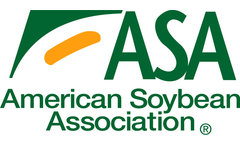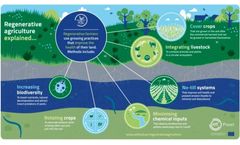Conservation Versus Conventional Tillage Articles & Analysis
18 articles found
The Environmental Protection Agency has proposed several pesticide registration plans that could significantly affect farmers’ abilities to utilize herbicides. EPA is responsible for approving registrations on pesticides in the United States and has consistently been found by courts to have not properly evaluated the registrations’ effects on endangered species. In order to meet ...
In our recent blog on ‘Regenerative Agriculture and Climate Change,’ we explored the prospects of regenerative agriculture in combating climate change. Its benefits are continuously evolving and still core to controversial scientific debates. However, we concluded that regenerative agriculture is an approach that puts us in the right frame of mind. It means thinking beyond minimising ...
Like any business, farmers must manage their farms with one foot in the present and the other in the future. It’s not enough to focus just on yields. We must also consider the impact those yields have on our fields. To ensure sustainable crop production, the implementation of a method like conservation tillage is vital. Conservation tillage is a tilling process that leaves at least ...
ByGrowers
Agriculture degrades over 24 million acres of fertile soil every year, raising concerns about meeting the rising global demand for food. But a simple farming practice born from the 1930's Dust Bowl could provide a solution, according to new Stanford research. The study, published Dec. 6 in Environmental Research Letters, shows that Midwest farmers who reduced how much they overturned the soil -- ...
Despite the extensive use of the neonicotinoid insecticide clothianidin, and its known toxicity to beneficial insects like pollinators, little attention has been given to its fate under agricultural field conditions. The present study investigated the fate and toxicity of clothianidin applied every other year as a corn seed‐coating at two different rates, i.e., 0.25 and 0.50 mg/seed, in an ...
The objectives of the current study were to 1) determine the best tillage practice (conventional versus conservation tillage) in terms of grain yields and potential environmental risk, 2) assess insecticidal exposure using concentrations measured in soil and runoff water and sediments, 3) compare measured ...
A three-season research study was conducted at Embu Agricultural Research Station farm to determine the effect of glyphosate-based herbicides on weeds management and maize ( Zea mays L. ) performance under zero-tillage conservation agriculture practice. Glyphosate herbicide sprays were prepared from Roundup Turbo product at the rate of 2.5 L ha –1 and Roundup Weathermax at 1.5, 2.5 and 3.0 L ...
The concept of critical source areas of phosphorus (P) loss produced by coinciding source and transport factors has been studied since the mid 1990s. It is widely recognized that identification of such areas has led to targeting of management strategies and conservation practices that more effectively mitigate P transfers from agricultural landscapes to surface waters. Such was the purpose of P ...
Conservation tillage, besides being more economical, prevents soil erosion and has other beneficial effects on our environment, but few studies have been conducted on differential responses of different crops to conservation tillage. The main objective of this study was to examine the interaction of tillage with crop species. Rainfed field experiments in a strip-plot design with four replicates ...
The use of crop rotation systems involving winter-annual grazing can help peanut (Arachis hypogaea L.) producers increase profitability, although winter-annual grazing could result in excessive soil compaction, which can severely limit yields. We conducted a 3-yr field study on a Dothan loamy sand in southeastern Alabama to develop a conservation tillage system for integrating peanut with ...
As economic conditions deteriorated, cotton (Gossypium hirsutum L.) producers have looked to improve profit margins by reducing inputs while maintaining yields. Pairing the yield benefits from early planting with the input reductions from conservation tillage might help accomplish those goals. The objective was to determine how growth, lint yield, and fiber quality were impacted by planting ...
In dry land areas of the Mediterranean region, farmers' decisions are particularly difficult due to irregular rainfall. Yield risk, soil erosion and desertification are important problems. Decision-making behaviour of farmers is supposed to incorporate a particular concern in the adoption of strategies to decrease income variability, to conserve soil and to guarantee a comfortable level of ...
Row crop agriculture in California's San Joaquin Valley is a major contributor of particulate matter <10 µm in aerodynamic diameter (PM10). The California Air Resources Board uses fixed PM10 emission values for various tillage operations to monitor and design attainment strategies. However, fixed emission values do not reflect emissions produced by a single implement operating under different ...
Manure application in minimum till (MT) systems is a challenge worthy of attention because residue cover is a keystone for environmental protection. To develop a system combining zone tillage and manure application into one operation (zonejection), two experiments were conducted. In Exp. 1, liquid swine manure (LSM) was applied in fall or spring for two site years (A, B). In Exp. 2, LSM was ...
Conservation tillage is a commonly adopted best management practice for reducing runoff and erosion, and increasing infiltration. Yet current methodologies in place to monitor conservation tillage adoption are largely inappropriate for regional or national assessments. A major goal of this study was to evaluate the spectral response properties of four alternative winter cover crops using remotely ...
This paper surveys the level and distribution of economic impacts of GMOs in the Americas from 1996–2004. Key institutional factors influencing GMO diffusion are discussed. In 2004 the Americas accounted for 94% of world GMO area. Diffusion has been concentrated; four countries, four crops and two traits account for the vast majority of area. The economic benefits of the diffusion of GMOs have ...
The economic benefits of the adoption of conservation tillage depend on site-specific factors, including soil characteristics, local climatic conditions, cropping patterns, and other attributes of the overall farming operation. While it is possible to draw some general inferences about components of economic returns and costs, a comprehensive assessment of the net private benefits from greater ...
A number of policy tools are used to reduce soil erosion from agricultural lands in the USA, including education and technical assistance, financial assistance, land retirement, and conservation compliance requirements. Education and technical assistance by public and private sources can be effective in promoting the adoption of conservation tillage by farmers for whom that practice will be ...








